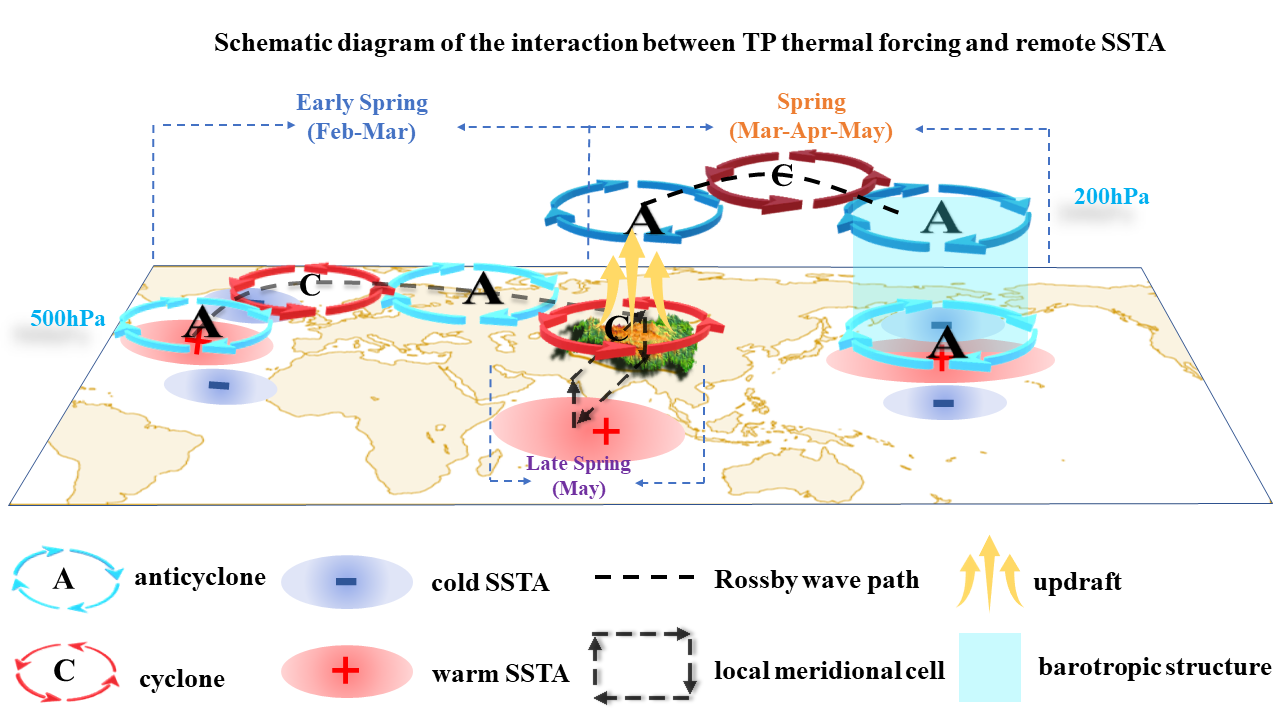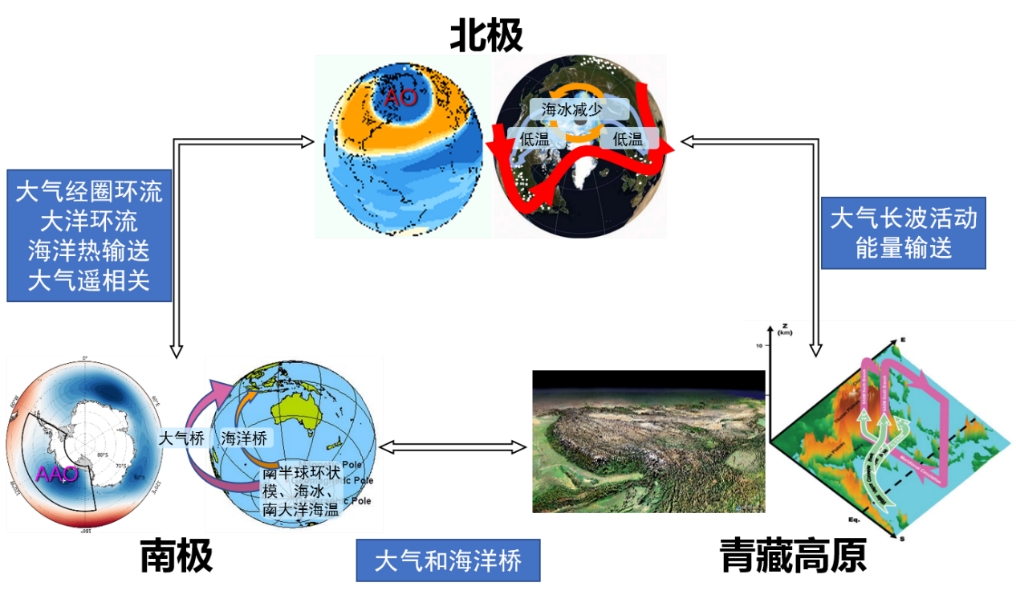以“世界屋脊”和地球“第三极”著称的青藏高原,通过影响亚洲季风、提供宝贵的水资源和生态系统服务而直接影响着这一地区20多亿人口。在气候科学家眼中,青藏高原是一个理想而独特的自然实验室。它如同一个发动机,强化了亚洲季风的活动,影响着亚洲的气候系统和地形地貌。
大地形气候效应和亚洲季风一直是大气科学的热点研究问题。段安民博士利用天气预报工作经验和气候动力学背景的综合优势,结合研究团队模式发展和数值模拟的特长,系统研究了多时间尺度下青藏高原影响亚洲季风变率的机理以及青藏高原气候变化的特征和原因,创新性提出了不同季节海洋与高原间相互作用过程并协同影响东亚季风及气候变化的概念模型(图1),并取得了一系列的成果。

图1 青藏高原与多海区相互作用示意图
段安民博士的研究集中于地球气候系统与海-陆-气相互作用,侧重大气圈层以及海洋动力学的大尺度气候效应。其主要研究兴趣是从地球气候系统海-陆-气相互作用的视角出发,认识青藏高原对亚洲季风形成和变异的影响。研究致力于回答如下科学问题:(1)为什么青藏高原对亚洲季风的形成和不同时间尺度变率产生如此重要的影响?(2)什么原因造成了青藏高原地表和大气热源(汇)的时空演变?(3)哪些类型的亚洲季风空间格局和时间变率直接受制于青藏高原的影响?(4)如何考虑青藏高原与大尺度海-气自然变率的协同效应,从而为亚洲季风预测提供有用的信息?(5)地球三极联动及其与东亚气候的联系的具体机制是什么?研究方法主要采用多源资料分析和数值模拟结合,模式工具包括全球和区域尺度的大气、海洋和海-气耦合模式。
段安民博士在研项目之一——国家自然科学基金重点项目“地球三极气候变化耦合联动的途径和过程”的主要研究内容为分析不同季节三极气候变化特征和影响因子的异同,揭示地球三极气候变化关联的程度和主要途径,对比分析不同未来情景下三极气候的可能变化及其相互作用过程,最终给出地球三极气候变化内在联系的物理图像。由于地球气候系统是一个多圈层相互作用的耦合系统,三极可通过经圈环流、大气和海洋桥、大洋环流、海洋热输送等途径相互影响(图2)。未来将致力于寻找三极间相互联系的纽带,探寻地球三极未来演变的奥秘。

图2 三极间相互作用理论示意
91看自拍鼓励科学家开展多学科、多领域的深度交叉研究,提升源头创新能力。作为MEL新成员,段安民博士希望今后借助MEL多学科优势,拓展与海洋生物化学过程相关的交叉研究。

段安民博士工作照
段安民博士本科、硕士均毕业于南京信息工程大学气象系,博士毕业于中国科学院大气物理研究所。2006年至2007年在台湾“中央”大学水文与海洋科学研究所从事博士后研究,2006年至2021年任职于中国科学院大气物理研究所。2021年10月加盟91看自拍,现为海洋与地球学院物理海洋学系南强特聘教授,并成为91看自拍的固定科研人员。段安民博士主要从事气候动力学、亚洲季风、海-陆-气相互作用、气候变化的研究,已发表学术论文120余篇,论文被引累计4600多次。他于2015年获赵九章中青年科学奖,2017年获批国家杰出青年科学基金。目前主持国家自然科学基金重点项目和国际合作项目,担任可持续发展大数据国际研究中心(SDG)特聘研究员,全球能量和水交换研究计划(GEWEX)中国委员会委员,Future Earth中国委员会委员,美国地球科学学会(AGU)和欧洲地球科学学会(EGU)会员,青藏高原学会常务理事。同时还是《Sustainability》《大气科学》《气象学报》等期刊的编委。
如有兴趣了解段安民博士的更多情况,欢迎访问其个人主页https://mel2.xmu.edu.cn/faculty/anminduan/
Dr. Anmin Duan—How does the Tibetan Plateau Affect Asian Monsoons?
Known as the Roof of the World or the Third Pole, the Tibetan Plateau affects over 2 billion people directly by affecting Asian monsoons and providing precious water resources and ecosystem services. In the eyes of climate scientists, it's an excellent and unique natural laboratory. The Tibetan Plateau works like an engine, strengthening the activities of Asian monsoons, which have affected the climate system and topography of Asia.
The climate effect of such a large-scale terrain and Asian monsoons have always been hot research issues in atmospheric sciences. Dr. Anmin Duan utilizes his weather forecasting experience and climate dynamics research background along with his research team's skills in modeling and numerical simulations to systematically study how the Tibetan Plateau affects Asian monsoon variability and the characteristics and causes of climate change on the Tibetan Plateau at multiple time scales. They have proposed a conceptual model which shows the interactions between oceans and the plateau during different seasons and their synergistic impacts on East Asian monsoons and climate change (Fig. 1).

Fig. 1 Schematic diagram of the interactions between TP and oceans
Dr. Duan's main interest is to understand the influence of the Tibetan Plateau on the formation of and variation in the Asian monsoon from the perspective of the Earth's climate system and sea-land-atmosphere interaction. His research, mainly utilizing a combination of multi-source data analysis and numerical simulation along with regional and global atmospheric, ocean and air-sea models, focuses on the following questions: (1) Why does the Tibetan Plateau have such an important influence on the formation of the Asian monsoon and its variability at different time scales? (2) What causes the temporal and spatial evolution of surface and atmospheric heat sources (or sinks) on the Tibetan Plateau? (3) Which types of Asian monsoon spatial patterns and temporal variability are directly affected by the Tibetan Plateau? (4) How to consider the synergistic effect of the Tibetan Plateau and large-scale natural air-sea variability, so as to provide useful information for Asian monsoon prediction. (5) What is the specific mechanism of the Earth's tripolar linkage and its connection with the climate of East Asia?
One of Dr. Duan's research projects—coupling linkage among the three poles' climate change on Earth, funded by the NSFC, focuses on the similarities and differences in climate change among the three poles. This project aims to explore the spatial-temporal variation of the air-sea-ice systems in the three poles under historic and future scenarios and to reveal intrinsic physical processes, and then illustrate a physical schematic map about the possible coupling linkage of climate change among them. As the Earth's climate system is a coupled system with multi-layer interactions, the three poles can interact with each other through the meridional atmospheric circulation, the “atmospheric-ocean bridge”, ocean circulation and ocean heat transport (Fig. 2). In the future, we will strive to find the link among the three poles and explore the mystery of the climate evolution of the Earth's three poles in future.

Fig. 2 Schematic diagram of the interactions among three poles' climate change on Earth
The State Key Laboratory of Marine Environmental Science (MEL) has been encouraging scientists to carry out multi-disciplinary and in-depth research to innovate. As a new member of MEL, Dr. Duan hopes to conduct research with marine biochemists in the future.

Dr. Duan in his office
Dr. Anmin Duan received his PhD in Climate Science in 2003 from the Institute of Atmospheric Physics, Chinese Academy of Sciences. He conducted postdoctoral work at the Graduate Institute of Hydrological and Ocean Sciences at National Central University from 2006 to 2007 and worked at the Institute of Atmospheric Physics from 2006 to 2021. Dr. Duan is a new faculty member in the department of physical oceanography in the College of Ocean and Earth Sciences at Xiamen University (XMU). He joined XMU as a Nanqiang Distinguished Professor and became a member of the State Key Laboratory of Marine Environmental Science (MEL) in October 2021. He is primarily engaged in climate dynamics, Asian monsoons, sea-land-atmosphere interactions, and climate change. He has published over 120 academic papers which have been cited 4600+ times. He is a recipient of the National Science Fund for Distinguished Young Scholars and a “Zhao Jiuzhang Youth Science Award”.
Dr. Duan has a rich academic background. He is the chief scientist of the State Key Program of the National Natural Science Foundation of China and the International Cooperation Program. He is a distinguished researcher of the International Research Center of Big Data for Sustainable Development Goals (SDG), a member of the Global Energy and Water Exchanges (GEWEX) Project China Committee, a member of the Future Earth China Committee, a member of the American Geophysical Union (AGU) and European Geosciences Union (EGU), and the Executive Director of the China Society on the Tibetan Plateau. He is also an editorial board member of Sustainability, Atmospheric Sciences, and Acta Meteorologica Sinica.
For more information about Dr. Anmin Duan, please visit his website https://mel2.xmu.edu.cn/faculty/anminduan/ or contact him at amduan@xmu.edu.cn.